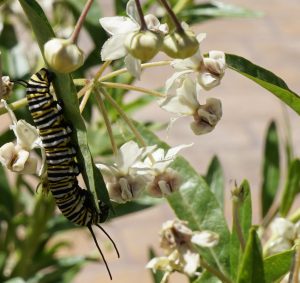I am so behind on planned posts! I have a piece of digital artwork featuring the western tiger Swallowtail butterfly that I want to include in a post that discusses the Swallowtail in some detail, but I am only about halfway through the layers that I am using to create a composite image.
So, I decided to post an update on a project I started about a year ago, something that I could knock out with a smaller time investment, an update on my backyard milkweed and monarchs project.
In this post from July 8, 2016, I documented the first appearance of a monarch butterfly in our yard. She showed up a few months after I planted some Narrowleaf milkweed (Asclepias fascicularis), a native in our area that is currently in bloom in places along the Albertson Fire Road and on some of the single track trails in the area. I should point out that the milkweed appears to be competing for space, moisture and pollinators with the non-native mustard plants that turn the hills a glorious yellow in the spring. I have taken to pulling out encroaching mustard plants during my hikes, but only when there are no mountain bikers or hikers around because most people will not understand what I am doing–it looks like I am destroying nature instead of trying to give the Narrowleaf a better chance to fight against what is, in the Santa Monica Mountains, an invasive weed. Certainly during my first spring here, I had no idea that the plant that made the hills so yellow in the spring and attracted nesting Red-winged Blackbirds in quantities up on the Autumn Ridge trail was a problem for native plants.
Now, on to the actual update. Most of the Narrowleaf species planted last year in our yard have returned, but they remain small and it is not clear whether they will thrive. Even the tallest among them cannot sustain the voracious appetite of one caterpillar through five instars. From what I have observed on the mountain trails, it can take a few years for the Narrowleaf to establish itself to the point where it becomes a robust and tough plant that can grow tall and produce many leaves and flowers.
In the meantime, I continue to cultivate a fast-growing, non-native that is not invasive: Asclepius physocarpa aka Balloon Plant or Family Jewels. This spring six monarchs have already reached maturity on these plants. Here is a member of the two or three caterpillar generations currently developing on the plants.

This morning a female visitor added a new generation.

In closing, something native but completely different, now blooming in our front yard: the fragrant Salvia clevelandii.

